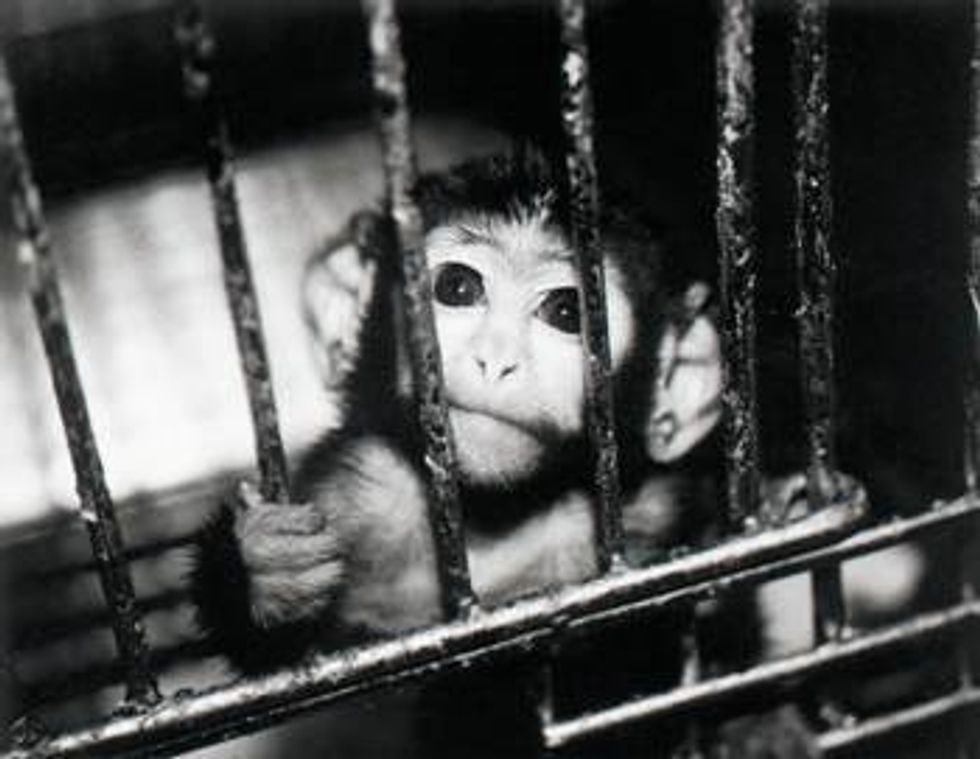More than 100 million animals die annually due to animal testing, according to Peta. In this article, I’m going to tell you the history of animal testing, how the animals are treated, why the animals are used, myths of animal testing, and why it is bad.
To start off, let's talk about the history of animal testing. Animal testing was started by an Arabic physician named Ibn Zuhr that practiced on a goat. Animal testing has grown since 1933 when a lady had a reaction to a company’s eyeliner that made her eyes burn, and later blind. According to "History on Animal Testing" by Abhijit Naik, this pushed for the Federal Food, Drug, and Cosmetic Act in 1933. Since then, harmful animal testing has affected rabbits, mice, cats, dogs, monkeys, and chimps.
If you were wondering in what conditions the animals are held and how they are treated during the testing, they are treated very harshly and are confined to small cages. On procon.org, it states that while testing is going on, animals are deprived of food and water and are later affected by self-mutilation and depression. They are also subjected to forced feeding, inhalation, and injection.
So why are animals used at all? According to the humanesociety.org, those animals are used for product and medicinal testing. Animals test over 3,000 products a year. Drugs in the pharmacy or even the Pantene shampoo in your shower are tested by animals, sometimes to even a surplus amount. But even that doesn't really answer why the animals are being used, since there is no real good reason. We don't need to be testing on animals at all! Especially for cosmetic products that we as humans don't need and definitely do not need to be tested on any animal.
Along with all of these facts about animal testing, there are so many myths as well. One myth, found on Animal Liberation Front's website, is that scientists say animals are more accurate than computerized testing. Animals actually have different anatomic, metabolic, and cellular set-ups which make the testings only 5-25% accurate. Another myth is that computer testing is more expensive and less effective. BUT computerized testing is 65% more accurate and thousands of dollars cheaper. The organ chip brought on by the Wyss Institute at Harvard has proved these more beneficial effects. The organ chip contains human cells, airway cells, and blood capillaries that are put into a membrane to react to the drugs and products.
Hopefully from reading this, you've inferred that animal testing is something that needs to change. Why exactly is animal testing bad? According to procon.org, animal testing is bad because it is inaccurate and expensive, very harmful to animals, and it impacts the environment. Using certain animals (like chimps for example) helps to speed up the species' extinction according to neavs.org. It is pointless to have these animals in testing because as I've stated before, it really isn’t accurate. Animals have different structures than us and it is way too costly for the false information it is providing scientists. Animal testing is very harmful to animals because it mutilates the animals and causes the animals to become depressed. According to peta.org, some side effects from the animals being tested on are that they end up having brain tumors and diseases on their skin from the products being tested. After animals are tested they are usually killed. They live a horrible torturous life and are killed when their agony (being tested on) is no longer needed. Animal testing is also very old, and it still uses procedures from the 40's and 50's. Now that you know the history behind animal testing, how they are treated, why they are used, myths of animal testing, and why you should be against animal testing, go out and start purchasing products not tested on furry helpless animals.
If this hasn't helped persuade you in any way, please feel free to check out these two videos. The first video found on Peta's website shows the horrors of what animals go through and offer some more facts, while the second video found on Harvard's Wyss Institute website (mentioned above http://wyss.harvard.edu/viewpage/293/) shows an alternative for animal testing that is accurate and doesn't harm anyone or anything in the testing process.
If you are unsure as to whether or not your products are being tested on animals, you can search different products on Peta's website at this link: http://features.peta.org/cruelty-free-company-search/index.aspx or you can just look for a little picture of a bunny on your products, which means that they have not been animal tested. Make sure to do your research though, because there are ways for companies to seem as though they are distancing themselves from the animal testing controversy while still testing. Examples of this are third party testing (where a partner company may have been the one to actually do the testing) and misleading labels that state that the product wasn't tested on animals when that specific chemical compound may not have been tested on animals, but the different compounds before that one were.





















